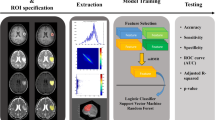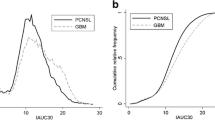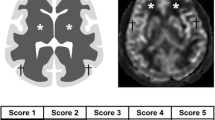Abstract
Objectives
To evaluate the diagnostic performance of magnetic resonance (MR) radiomics-based machine-learning algorithms in differentiating primary central nervous system lymphoma (PCNSL) from non-necrotic atypical glioblastoma (GBM).
Methods
Seventy-seven patients (54 individuals with PCNSL and 23 with non-necrotic atypical GBM), diagnosed from January 2009 to April 2017, were enrolled in this retrospective study. A total of 6,366 radiomics features, including shape, volume, first-order, texture, and wavelet-transformed features, were extracted from multi-parametric (post-contrast T1- and T2-weighted, and fluid attenuation inversion recovery images) and multiregional (enhanced and non-enhanced) tumour volumes. These features were subjected to recursive feature elimination and random forest (RF) analysis with nested cross-validation. The diagnostic abilities of a radiomics machine-learning classifier, apparent diffusion coefficient (ADC), and three readers, who independently classified the tumours based on conventional MR sequences, were evaluated using receiver operating characteristic (ROC) analysis. Areas under the ROC curves (AUC) of the radiomics classifier, ADC value, and the radiologists were compared.
Results
The mean AUC of the radiomics classifier was 0.921 (95 % CI 0.825–0.990). The AUCs of the three readers and ADC were 0.707 (95 % CI 0.622–0.793), 0.759 (95 %CI 0.656–0.861), 0.695 (95 % CI 0.590–0.800) and 0.684 (95 % CI0.560–0.809), respectively. The AUC of the radiomics-based classifier was significantly higher than those of the three readers and ADC (p< 0.001 for all).
Conclusions
Large-scale radiomics with a machine-learning algorithm can be useful for differentiating PCNSL from atypical GBM, and yields a better diagnostic performance than human radiologists and ADC values.
Key Points
• Machine-learning algorithm radiomics can help to differentiate primary central PCNSL from GBM.
• This approach yields a higher diagnostic accuracy than visual analysis by radiologists.
• Radiomics can strengthen radiologists’ diagnostic decisions whenever conventional MRI sequences are available.






Similar content being viewed by others
Abbreviations
- ADC:
-
Apparent diffusion coefficient
- AUC:
-
Area under the receiver operating characteristic curve
- CETs:
-
Contrast-enhancing tumours
- T1C:
-
Contrast-enhanced T1-weighted
- DTI:
-
Diffusion-tensor imaging
- TE:
-
Echo time
- FOV:
-
Field of view
- FLAIR:
-
Fluid-attenuation inversion recovery
- GBM:
-
Glioblastoma
- GLCM:
-
Grey level co-occurrence matrix
- GLRM:
-
Grey-level run length matrix
- GLSZM:
-
Grey-level size zone matrix
- MRI:
-
Magnetic resonance imaging
- NET:
-
Non-enhancing tumour tissue and oedema
- PCNSL:
-
Primary central nervous system lymphoma
- RF:
-
Random forest
- rCBV:
-
Relative cerebral blood volume
- TR:
-
Repetition time
- T2:
-
T2-weighted
References
Haldorsen IS, Espeland A, Larsson EM (2011) Central nervous system lymphoma: characteristic findings on traditional and advanced imaging. AJNR Am J Neuroradiol 32:984–992
Dolecek TA, Propp JM, Stroup NE, Kruchko C (2012) CBTRUS statistical report: primary brain and central nervous system tumors diagnosed in the United States in 2005-2009. Neuro-Oncology 14(Suppl 5):v1–49
Schlegel U (2009) Primary CNS lymphoma. Ther Adv Neurol Disord 2:93–104
Stupp R, Mason WP, van den Bent MJ et al (2005) Radiotherapy plus concomitant and adjuvant temozolomide for glioblastoma. N Engl J Med 352:987–996
Kickingereder P, Wiestler B, Sahm F et al (2014) Primary central nervous system lymphoma and atypical glioblastoma: multiparametric differentiation by using diffusion-, perfusion-, and susceptibility-weighted MR imaging. Radiology 272:843–850
Koeller KK, Smirniotopoulos JG, Jones RV (1997) Primary central nervous system lymphoma: radiologic-pathologic correlation. Radiographics 17:1497–1526
Rees JH, Smirniotopoulos JG, Jones RV, Wong K (1996) Glioblastoma multiforme: radiologic-pathologic correlation. Radiographics 16:1413–1438 quiz 1462-1413
Al-Okaili RN, Krejza J, Woo JH et al (2007) Intraaxial brain masses: MR imaging-based diagnostic strategy--initial experience. Radiology 243:539–550
Buhring U, Herrlinger U, Krings T, Thiex R, Weller M, Kuker W (2001) MRI features of primary central nervous system lymphomas at presentation. Neurology 57:393–396
Doskaliyev A, Yamasaki F, Ohtaki M et al (2012) Lymphomas and glioblastomas: differences in the apparent diffusion coefficient evaluated with high b-value diffusion-weighted magnetic resonance imaging at 3T. Eur J Radiol 81:339–344
Toh CH, Wei KC, Chang CN, Ng SH, Wong HF (2013) Differentiation of primary central nervous system lymphomas and glioblastomas: comparisons of diagnostic performance of dynamic susceptibility contrast-enhanced perfusion MR imaging without and with contrast-leakage correction. AJNR Am J Neuroradiol 34:1145–1149
Liao W, Liu Y, Wang X et al (2009) Differentiation of primary central nervous system lymphoma and high-grade glioma with dynamic susceptibility contrast-enhanced perfusion magnetic resonance imaging. Acta Radiol 50:217–225
Radbruch A, Wiestler B, Kramp L et al (2013) Differentiation of glioblastoma and primary CNS lymphomas using susceptibility weighted imaging. Eur J Radiol 82:552–556
Choi YS, Lee H-J, Ahn SS et al (2017) Primary central nervous system lymphoma and atypical glioblastoma: differentiation using the initial area under the curve derived from dynamic contrast-enhanced MR and the apparent diffusion coefficient. Eur Radiol 27:1344–1351
Kickingereder P, Burth S, Wick A et al (2016) Radiomic Profiling of Glioblastoma: Identifying an Imaging Predictor of Patient Survival with Improved Performance over Established Clinical and Radiologic Risk Models. Radiology 280:880–889
Prasanna P, Patel J, Partovi S, Madabhushi A, Tiwari P (2017) Radiomic features from the peritumoral brain parenchyma on treatment-naive multi-parametric MR imaging predict long versus short-term survival in glioblastoma multiforme: Preliminary findings. Eur Radiol 27:4188–4197
Shinohara RT, Sweeney EM, Goldsmith J et al (2014) Statistical normalisation techniques for magnetic resonance imaging. Neuroimage Clin 6:9–19
van Griethuysen JJM, Fedorov A, Parmar C et al (2017) Computational Radiomics System to Decode the Radiographic Phenotype. Cancer Res 77:e104–e107
Kuhn M (2008) Building Predictive Models in R Using the caret Package. J Stat Softw 28:1–26
DeLong ER, DeLong DM, Clarke-Pearson DL (1988) Comparing the areas under two or more correlated receiver operating characteristic curves: a nonparametric approach. Biometrics 44:837–845
Toh CH, Castillo M, Wong AM et al (2008) Primary cerebral lymphoma and glioblastoma multiforme: differences in diffusion characteristics evaluated with diffusion tensor imaging. AJNR Am J Neuroradiol 29:471–475
Calli C, Kitis O, Yunten N, Yurtseven T, Islekel S, Akalin T (2006) Perfusion and diffusion MR imaging in enhancing malignant cerebral tumors. Eur J Radiol 58:394–403
Kickingereder P, Sahm F, Wiestler B et al (2014) Evaluation of microvascular permeability with dynamic contrast-enhanced MRI for the differentiation of primary CNS lymphoma and glioblastoma: radiologic-pathologic correlation. AJNR Am J Neuroradiol 35:1503–1508
Guo AC, Cummings TJ, Dash RC, Provenzale JM (2002) Lymphomas and high-grade astrocytomas: comparison of water diffusibility and histologic characteristics. Radiology 224:177–183
Yamasaki T, Chen T, Hirai T, Murakami R (2013) Classification of cerebral lymphomas and glioblastomas featuring luminance distribution analysis. Comput Math Methods Med 2013:619658
Alcaide-Leon P, Dufort P, Geraldo AF et al (2017) Differentiation of Enhancing Glioma and Primary Central Nervous System Lymphoma by Texture-Based Machine Learning. AJNR Am J Neuroradiol 38:1145–1150
Funding
This study was supported by a faculty research grant of Yonsei University College of Medicine (6 2016-0121).
Author information
Authors and Affiliations
Corresponding author
Ethics declarations
Guarantor
The scientific guarantor of this publication is Yoon Seong Choi.
Conflict of interest
The authors of this manuscript declare no relationships with any companies whose products or services may be related to the subject matter of the article.
Ethical approval
Institutional Review Board approval was obtained.
Informed consent
Written informed consent was waived by the Institutional Review Board.
Study subjects or cohorts overlap
Some study subjects or cohorts have been previously reported in European Radiology:
Choi YS, Lee H-J, Ahn SS, et al. Primary central nervous system lymphoma and atypical glioblastoma: differentiation using the initial area under the curve derived from dynamic contrast-enhanced MR and the apparent diffusion coefficient. Eur Radiol. 2017;27(4):1344–1351
Methodology
• retrospective
• observational
• performed at one institution
Electronic supplementary material
ESM 1
(DOCX 2057 kb)
Rights and permissions
About this article
Cite this article
Suh, H.B., Choi, Y.S., Bae, S. et al. Primary central nervous system lymphoma and atypical glioblastoma: Differentiation using radiomics approach. Eur Radiol 28, 3832–3839 (2018). https://doi.org/10.1007/s00330-018-5368-4
Received:
Revised:
Accepted:
Published:
Issue Date:
DOI: https://doi.org/10.1007/s00330-018-5368-4




